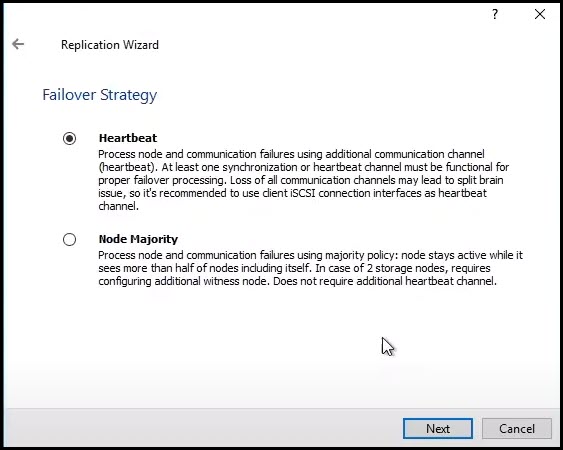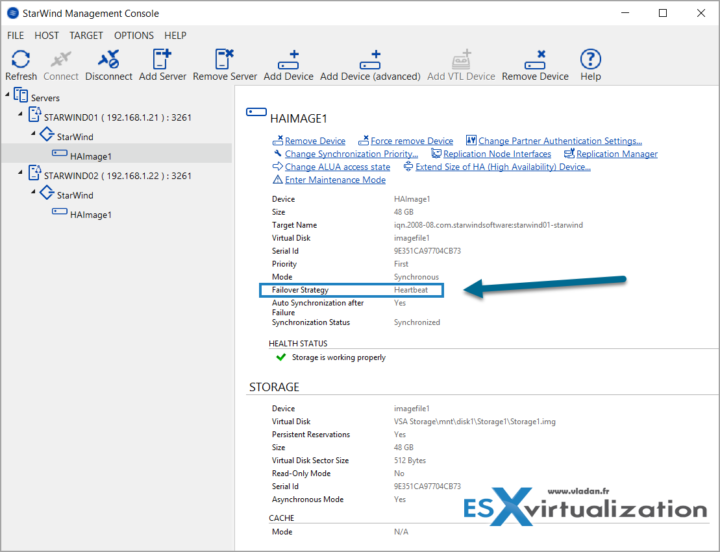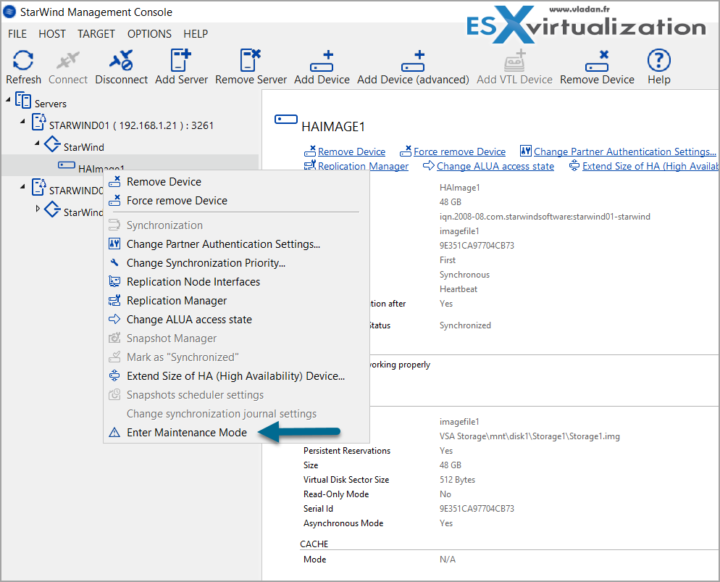Traditional storage systems often prove to be expensive and challenging to maintain. This is where StarWind Virtual SAN (VSAN) shines as a game-changing solution. In this blog post, we will delve into the intricacies of setting up a StarWind VSAN in a 2-node configuration without a witness node and explore how it provides a cost-effective, reliable, and high-performing solution for businesses.
When it comes to finding a cost-effective solution, StarWind VSAN might be the choice. The solution uses internal disks, SSDs, and RAM to build a cached pool of storage with minimum hardware. It is possible to build 2-node clusters only with 2 servers (hosts). A witness node is not necessary when selecting the Heartbeat failover strategy.
Heartbeat is a technology that allows avoiding the so-called “split-brain” scenario when the HA cluster nodes are unable to synchronize but continue to accept write commands from the initiators independently. It can occur when all synchronization and heartbeat channels disconnect simultaneously, and the partner nodes do not respond to the node’s requests. As a result, StarWind service assumes the partner nodes to be offline and continues operations on a single-node mode using data written to it.
By configuring heartbeat, you avoid so-called “split-brain”, situations when the HA cluster nodes are unable to synchronize but continue to accept write commands from the initiators. With StarWind Heartbeat technology, if the synchronization channel fails, StarWind attempts to ping the partner nodes using the provided heartbeat links.
If the partner nodes do not respond, StarWind assumes that they are offline. In this case, StarWind marks the other nodes as not synchronized, and all HA devices on the node flush the write cache to the disk to preserve data integrity in case the node goes out of service unexpectedly.

Note: If you chose the Node majority failover strategy, you'll need a Witness node.
StarWind VSAN is a software-defined storage solution that turns standard x86 servers into a shared storage platform. By doing this, StarWind reduces costs, increases storage capacity and reliability, and provides improved performance compared to traditional storage solutions.
One of the key advantages of StarWind VSAN is its cost-effectiveness. StarWind leverages commodity hardware, eliminating the need for expensive dedicated storage appliances. By using off-the-shelf components, you can reduce initial hardware costs significantly, making it a more affordable option for small and medium-sized businesses.
The 2-Node Setup Without a Witness Node
The most significant advantage of the 2-node setup without a witness node is cost savings. A witness node typically requires additional hardware, software, and maintenance, increasing the overall investment. By eliminating this component, you not only save on upfront costs but also reduce long-term operational expenses.
With fewer nodes to manage, the 2-node setup streamlines maintenance and reduces complexity. Fewer points of failure and less hardware to oversee mean fewer potential issues to address, making it a more manageable solution for businesses without extensive IT staff.
StarWind VSAN allows for easy scalability as your storage needs grow. You can start with a 2-node setup and add more nodes to your cluster, all without requiring a witness node. This flexibility ensures your storage infrastructure can adapt to your business's evolving demands.
In addition to cost savings and simplicity, StarWind VSAN delivers exceptional performance. The software is designed to maximize the potential of your existing hardware, ensuring optimal data throughput. Here's how it accomplishes this:
StarWind VSAN leverages a combination of SSD and HDD storage to deliver the best of both worlds. Frequently accessed data resides on fast SSDs, while less frequently used data is stored on larger and more cost-effective HDDs. This approach ensures high-speed data access without compromising on capacity.
StarWind employs efficient caching mechanisms that intelligently store frequently used data in memory, reducing latency and accelerating data access. This feature dramatically enhances the system's responsiveness and overall performance.
The software continually monitors the performance of each node and balances the data distribution to ensure no single node becomes a performance bottleneck. This dynamic load balancing is critical for maintaining consistent and high performance, especially in dynamic environments.
Synchronous Replication
Data is synchronously replicated between the two nodes, ensuring that every write operation is mirrored to both nodes simultaneously. This means that even in the event of a node failure, no data is lost, and the system can continue running seamlessly.
In a 2-node setup, failover mechanisms become crucial. StarWind VSAN includes built-in failover capabilities, and the Node Majority architecture ensures that the system can maintain quorum and data integrity, even if one node becomes unavailable.
Regular data scrubbing and self-healing mechanisms proactively identify and correct any issues with data integrity. This preventative approach minimizes the risk of data corruption and ensures that your data remains reliable over time.
Beyond its technical capabilities, StarWind VSAN offers excellent customer support and an active user community. This means you can count on assistance when you need it and collaborate with others who have experience with the platform. This support network is invaluable for businesses that want to make the most of their storage solution and ensure the highest levels of reliability.
Maintenance on a node? No problem, there is a Maintenance Mode!
When you need and plan upgrades or hardware maintenance on a node, or planned stops, or planned power outage, etc. When turning the nodes back on, and resuming their production operation, it is better to have fully-synchronized data on all nodes and avoid a long synchronization process that can take a considerable amount of time in most production environments. You can do it by putting your nodes into maintenance mode!
Quote from StarWind
The enabling of the Maintenance mode in StarWind Management Console before planned shutdowns saves the time required for data synchronization between the nodes after exiting the Maintenance mode and simplifies the process of making any changes in highly-available production environments.
To simplify the production startup after the scheduled service interruption, just turn on the Maintenance mode before performing various actions (shutdown, reboot, etc.) on the nodes. Even if nodes are turned off incorrectly after entering the Maintenance mode, all data will be safe. After finishing the operations on the nodes, just exit the Maintenance mode. As soon as this has been done, production can be launched without any need to wait for either fast or full synchronization. The only thing that should be checked is connectivity between the devices under maintenance.
The pop-up window shows you that your clients will be disconnected.
Final Words
StarWind VSAN is a cost-effective, reliable, and high-performing storage solution that is well-suited for a 2-node setup without a witness node. By eliminating the need for an additional node, it reduces costs and simplifies maintenance without compromising performance and reliability. Whether you're a small business looking for an affordable storage solution or a larger enterprise seeking to optimize your infrastructure, StarWind VSAN provides a compelling and efficient solution that checks all the right boxes.
Its architecture, exceptional performance, and robust support and community make it a powerful choice in the world of software-defined storage. Don't let storage costs and complexity hold you back—consider StarWind VSAN for your storage needs and unlock a world of possibilities for your business.
StarWind website here
More posts about StarWind on ESX Virtualization:
- You can’t extend backup window – Check NVMe Backup Appliance from StarWind
- Replacing Aging Hardware SAN Device by a Software – StarWind VSAN
- StarWind V2V Converter (PV2 Migrator) FREE utility
- Cluster with 2-Nodes only – How about quorum?
- StarWind VSAN Latest update allows faster synchronization with storing synchronization journals on separate storage
- How to Update StarWind VSAN for VMware on Linux- Follow UP
- Protect your Backups with Wasabi Immutable Storage Buckets and StarWind VTL
- StarWind SAN & NAS software details for VMware and Hyper-V
- Free StarWind iSCSI accelerator download
- VMware vSphere and HyperConverged 2-Node Scenario from StarWind – Step By Step(Opens in a new browser tab)
- StarWind Storage Gateway for Wasabi Released
- How To Create NVMe-Of Target With StarWind VSAN
- Veeam 3-2-1 Backup Rule Now With Starwind VTL
- StarWind and Highly Available NFS
- StarWind VVOLS Support and details of integration with VMware vSphere
- StarWind VSAN on 3 ESXi Nodes detailed setup
- VMware VSAN Ready Nodes in StarWind HyperConverged Appliance
More posts from ESX Virtualization:
- VMware vSphere 8.0 U2 Released – ESXi 8.0 U2 and VCSA 8.0 U2 How to update (NEW)
- What’s the purpose of those 17 virtual hard disks within VMware vCenter Server Appliance (VCSA) 8.0?
- VMware vSphere 8 Update 2 New Upgrade Process for vCenter Server details
- VMware vSAN 8 Update 2 with many enhancements announced during VMware Explore
- What’s New in VMware Virtual Hardware v21 and vSphere 8 Update 2?
- Homelab v 8.0
- vSphere 8.0 Page
- Veeam Bare Metal Recovery Without using USB Stick (TIP)
- ESXi 7.x to 8.x upgrade scenarios
- A really FREE VPN that doesn’t suck
- Patch your ESXi 7.x again
- VMware vCenter Server 7.03 U3g – Download and patch
- Upgrade VMware ESXi to 7.0 U3 via command line
- VMware vCenter Server 7.0 U3e released – another maintenance release fixing vSphere with Tanzu
- What is The Difference between VMware vSphere, ESXi and vCenter
- How to Configure VMware High Availability (HA) Cluster
Stay tuned through RSS, and social media channels (Twitter, FB, YouTube)



